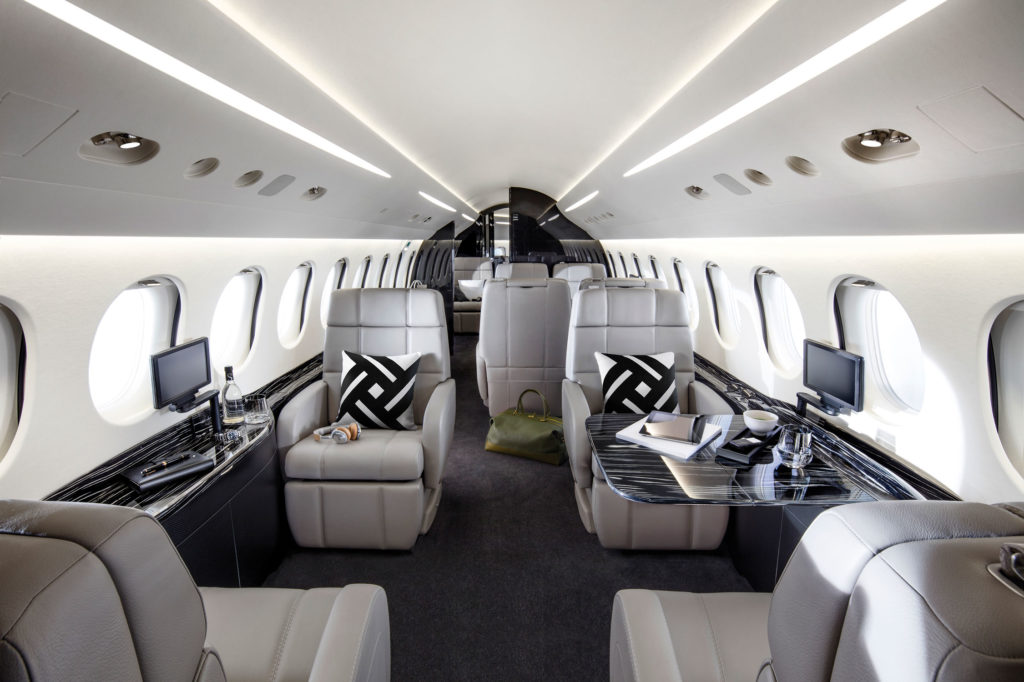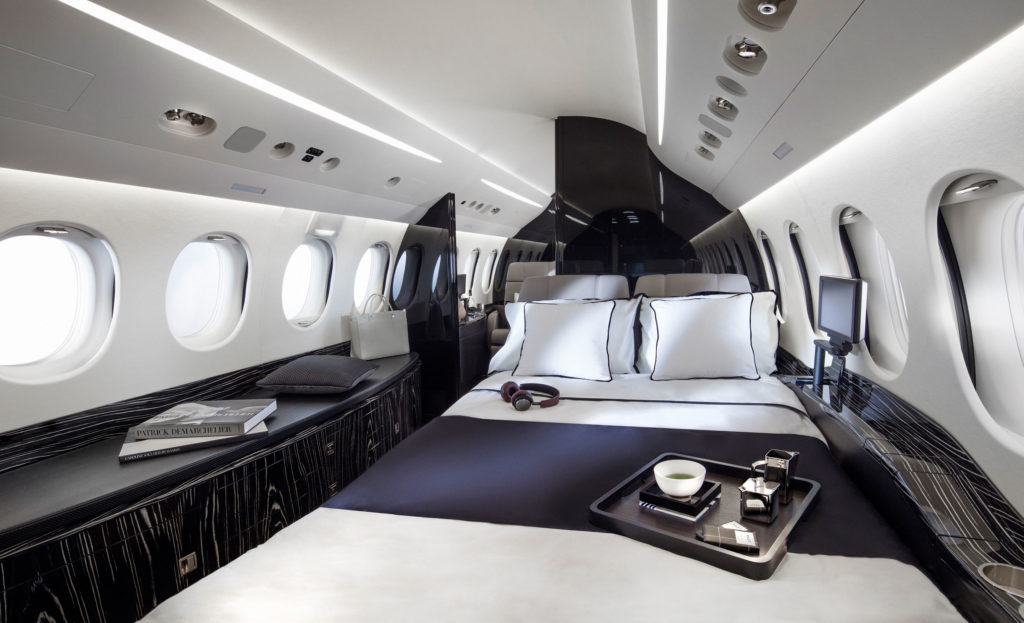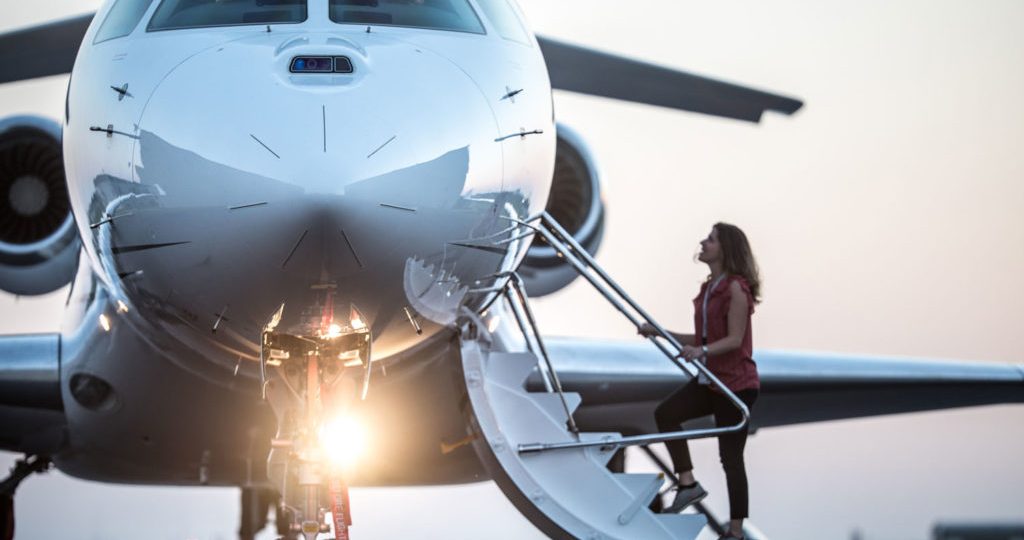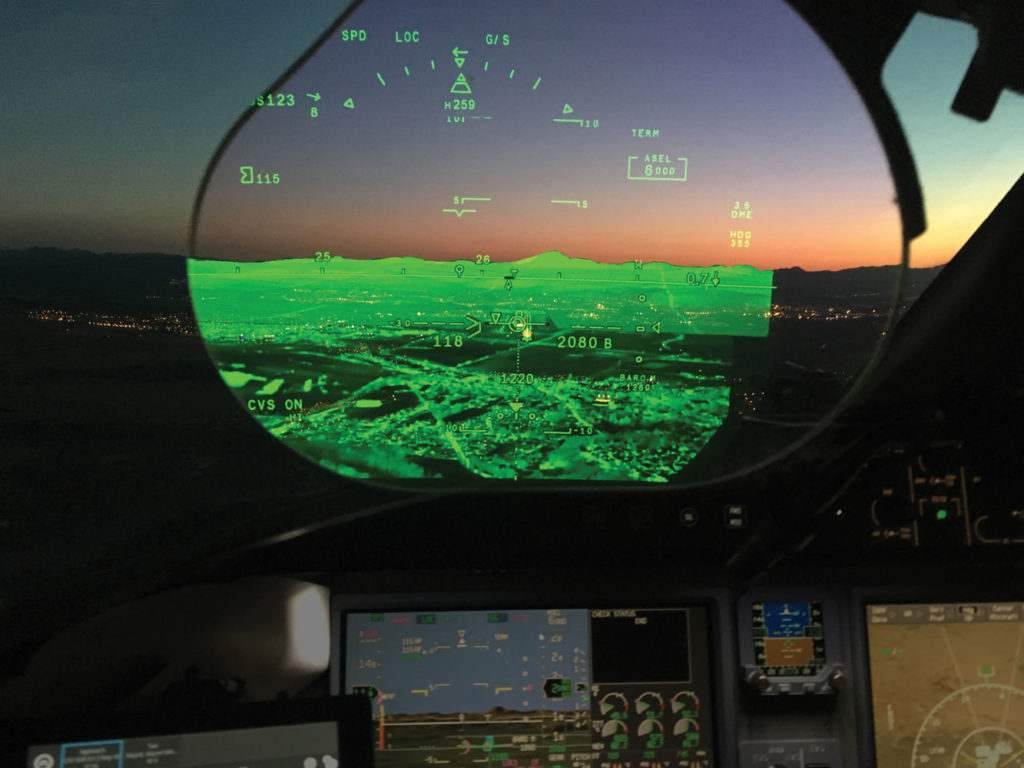Lean, Green & Quite Supreme
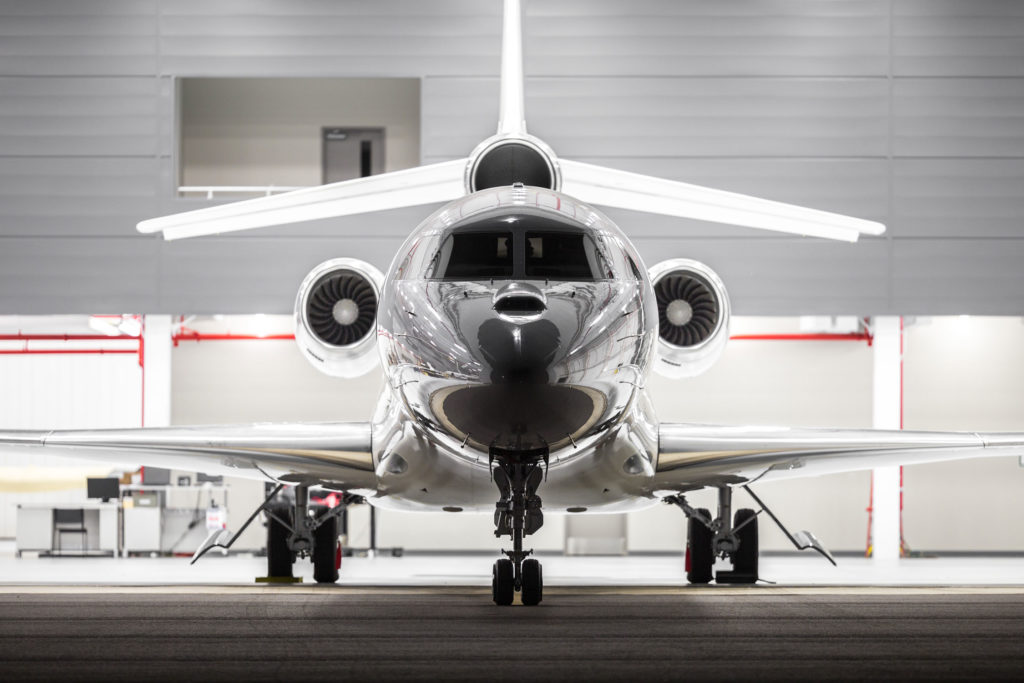
Thirty different cabin layouts
The 8X is about 80ft long and has a wingspan of over 86ft. Despite having smaller outside dimensions than its competitors, the cabin space is about the same size as other long-range business jets. The cabin is almost 43ft long and a very comfortable 92 inches wide. At 74 inches, it’s as tall as its competitors. The baggage compartment is not only large, but efficiently shaped. There are three families of floor plans with short, medium and large entryways offering more than 30 possible layouts, including one with a shower configuration. A crew rest area is also an option. The many windows, 32 to be exact, allow floods of ambient light.
There are some great cabin amenities too. The pullout tables are electric, there is a Falcon Cabin HD+Management System, dual Blu-Ray players, a 3D Airshow moving iPad map, Iridium or Inmarsat/ATG high-speed internet, HD colour monitors up to 32 inches, a great audio system, a Skybox system to stream movies to iPads and external cameras to feel as one with the sky. So what does it feel like to be a passenger in the cabin? Strange is the first word that came to mind when I considered we were slicing through the sky at warp-speed. It was eerily quiet, or about 3db quieter than the already incredibly quiet 7X cabin.
Automation
Back in the cockpit, starting the engines is a two-button affair. The rest is all automated. Pre-departure checks are simple and quickly dispensed with. I was afraid taxiing would be less than smooth and my fears were both warranted and quickly assuaged. It takes a few turns to get used to taxiing without a tiller and the digital nose wheel system is good and proportional. I find the rudder pedals are positioned a little high for my taste, but that’s a matter of taste. I found the brakes touchy, but I’m sure the cause of the rather abrupt braking was none other than yours truly sitting in the left seat.
The landing gear does a superb job of absorbing runway imperfections and would later prove to do an equally great job of correcting my own landing imperfections. The side-stick controller feels great with just the right firmness. It took me about five seconds to forget I no longer had a yoke and 10 seconds to realise I didn’t miss it. I love not having to trim. The 8X is stable in its flight-path. You point the aircraft in any configuration and just about a millisecond later it trims itself and remains on the flight path you selected. It not only does a faster job of relieving stick pressures than any living pilot, it does it better too.
Dassault’s fighter aircraft DNA kicks in once airborne. The digital flight control system offers unmatched crispness in the air. The 8X flies so well I felt the autopilot is almost not necessary and I didn’t use it much. It’s too much fun to fly manually. I found myself thinking: ‘This is the most fun I’ve ever had in an aircraft’. The digital system dampens turbulence, enhancing comfort and greatly improves safety with its flight envelope protection. There is a multitude of computers to manage any potential flight control issues and four modes (Normal/Alternate/Direct & Back-Up Laws) to fly the aircraft. The fly-by-wire system is powered and managed by three main and three secondary flight control computers. In addition to the four modes previously stated, the fourth mode, Back-Up Mode is designed for temporary operation, while the crew recovers to a higher level of flight control system laws. The statistical chance of reaching bottom is virtually non-existent. You lose very little flight envelope protection when transitioning from normal law to alternate law in case of a system failure and should the system move to direct law you are left with an aircraft controlled by the pilot, just like any other regular aircraft. Should you accidentally approach a stall, the 8X will simply fly to the edge of the stall and stay there happily loafing about, but keeping you out of trouble.
Cheaper landing fees
Takeoff was brisk. V1 and Vr flew by in a flash and we were soon climbing like mad. A few air-traffic control mandated altitude restrictions later, we reached our cruise altitude and this is where the 8X shines. The aircraft’s maximum certificated ceiling is 51,000 feet, but we elected to remain lower. At 41,000 feet and ISA +10, I saw about 700 pounds per hour per engine at Mach .80. Surprisingly at
Mach .85 fuel consumption was only about 105 pounds per hour higher. Traditionally, fuel consumption tends to be exponential between those speeds yet this increase was linear.
There are three Pratt & Whitney PW307D engines powering this bird and they each produce 6720 lbs of thrust. That’s a lot of power for an aircraft whose maximum take-off weight is only 73,000 lbs. They are about five per cent more powerful than their predecessors, but surprisingly consume about two per cent less.
The lighter weight makes for cheaper landing fees and considerably less fuel consumption and cheaper operating costs compared to the competition. Balanced-field length is 5,880ft and landing distance is a measly 2,220ft, which means there are a lot more airports the 8X can operate out of. A sampling of those include challenging fields like Cannes, La Mole-St Tropez, Lugano, St Moritz, Aspen, Toluca, Lhasa, La Paz, Daocheng Yading and London City, of course. Actually, the 8X can depart from London City and make a good number of cities on the East Coast of the United States. It can also make Bermuda, Dubai, Lagos, Moscow and Novosibirsk without breaking a sweat. A high landing weight close to max takeoff weight also means flexibility when it comes to saving money by not having to refuel at some expensive airports.
Confidence builder
This fuel efficiency is achieved in part thanks to the 8X’s smaller footprint, so you’ll not only pay less for fuel, you’ll also save money on hangar space and equally important, you’ll increase your chance of finding overnight space on those days when a storm is looming large and everyone is looking for shelter.
The 8X behaves much the same regardless of weight. In the air it’s as aggressive as you want it to be or as docile as a little Cessna. Manoeuvring around the airport pattern, it’s easy to forget you have a massive airplane behind you. The sky was clear that day, but winds were gusting 12 to 20 knots. The 8X takes it all in its stride.
The Flight Path system means you point your circle where you want to go and that’s exactly where you’ll end up. I flew a steep approach to simulate a London City landing, but with some extra zest added to it. Even at a seemingly exaggerated angle I was able to stop the 8X in about 2,500ft on my second landing and without braking hard. Besides being awe-inspiring, the 8X is a confidence-builder.
The avionics are first rate and third-generation iterations of the Honeywell Primus Epic platform. It’s easy and intuitive enough for a first-time user to grasp the basics to operate the system, but complex enough to warrant dedicating the time to explore its full potential. More importantly, the system is easily scalable to accept improvements and meet future requirements. The new 3D radar is a joy to use and removes much of the skill needed to properly get an idea of the weather you need to deal with. A new FalconEye Combined Vision System (CVS) superposing Enhanced Vision System (EVS) with a Synthetic Vision System (SVS) in the Head Up Display is now certified. The SVS system can also be seen on the primary flight displays. There is an Enhanced Ground Proximity Warning System coupled with wind shear detection system, the latest version of Traffic Collision Avoidance System (TCAS II) and a Satellite Based Augmentation System/Localiser Performance with vertical guidance (SBAS/LPV) that allows for safer approaches at a multitude of airports. The 8X is equipped with Automatic Dependent Surveillance Broadcast out (ADSB-out) to comply with upcoming regulations. It is the same for Controller/Pilot Data Link Communication (CPDLC) requirements. An Automatic Descent Mode (ADM) in case of pilot incapacitation during a catastrophic depressurisation is a good thing to have too should it happen.
A Runway Awareness Advisory System (RAAS) is also always useful when operating into airports with multiple parallel runways.
A nation of engineers
You might be asking yourself, as the 8X is an electric airplane, what would happen should you not be able to produce much-needed electricity? It’s a fair question, with a solid answer. France is a nation of engineers and Dassault’s wizards have come up with failsafe solutions. There are three generators each producing 12KW (400A), one for each engine, along with five Permanent Magnetic Alternators providing additional independent sources of power to the Primary Flight Control System (PFCS) and Engine Electronic Controllers/Full Authority Digital Engine Control (EEC/FADEC). In the highly unlikely event they should all fail, there is a Ram Air Turbine (RAT) to produce ample electrical power and charge the aircraft batteries above 140 KIAS. Then there are batteries and a large APU, though it’s technically restricted to ground use. While an actual engine malfunction is a rare event in today’s world, ingesting a bird large enough to destroy an engine isn’t. However, an engine malfunction in the 8X is not considered an emergency. It’s merely an abnormal situation.
Green credentials
A great aircraft is not much more than the sum of its parts without proper support and here too Dassault rises to the challenge with a history of supporting aircraft even long out of production. There is almost a billion dollars worth of parts positioned throughout the world to assist clients in need of quick replacements. A dedicated team and the right support aircraft to rescue flights are ready to go anywhere in a matter of hours. These fully furnished support aircraft can not only bring much needed mechanics and parts to an aircraft in need, but are also able to transport stranded passengers to their destination.
Finally and certainly very importantly, the 8X is also considerably greener and gentler on the environment than other aircraft. It’s actually up to 35% kinder to planet earth than the competition. Dassault’s manufacturing processes have also been streamlined to benefit the environment. In the past 15 years the factories have reduced their energy consumption by 20% and water usage by 80%. These reductions were achieved while increasing aircraft production by 50%. These are not inconsequential numbers and more than confirm Dassault’s commitment to the environment.
In a nutshell, Dassault has achieved a technological tour de force with the 8X proving technology, combined with common sense and an ear for what clients want, can produce miracles.

